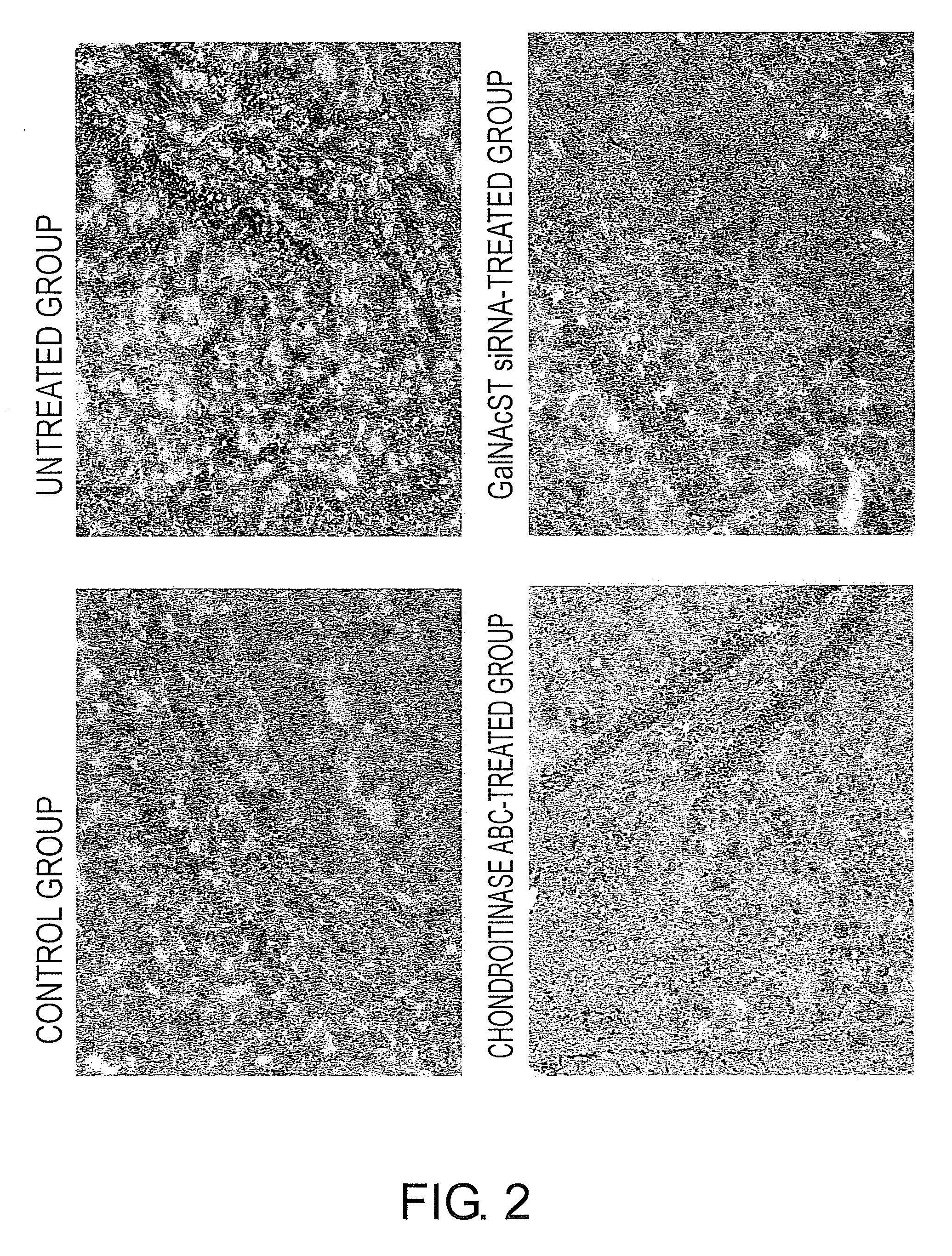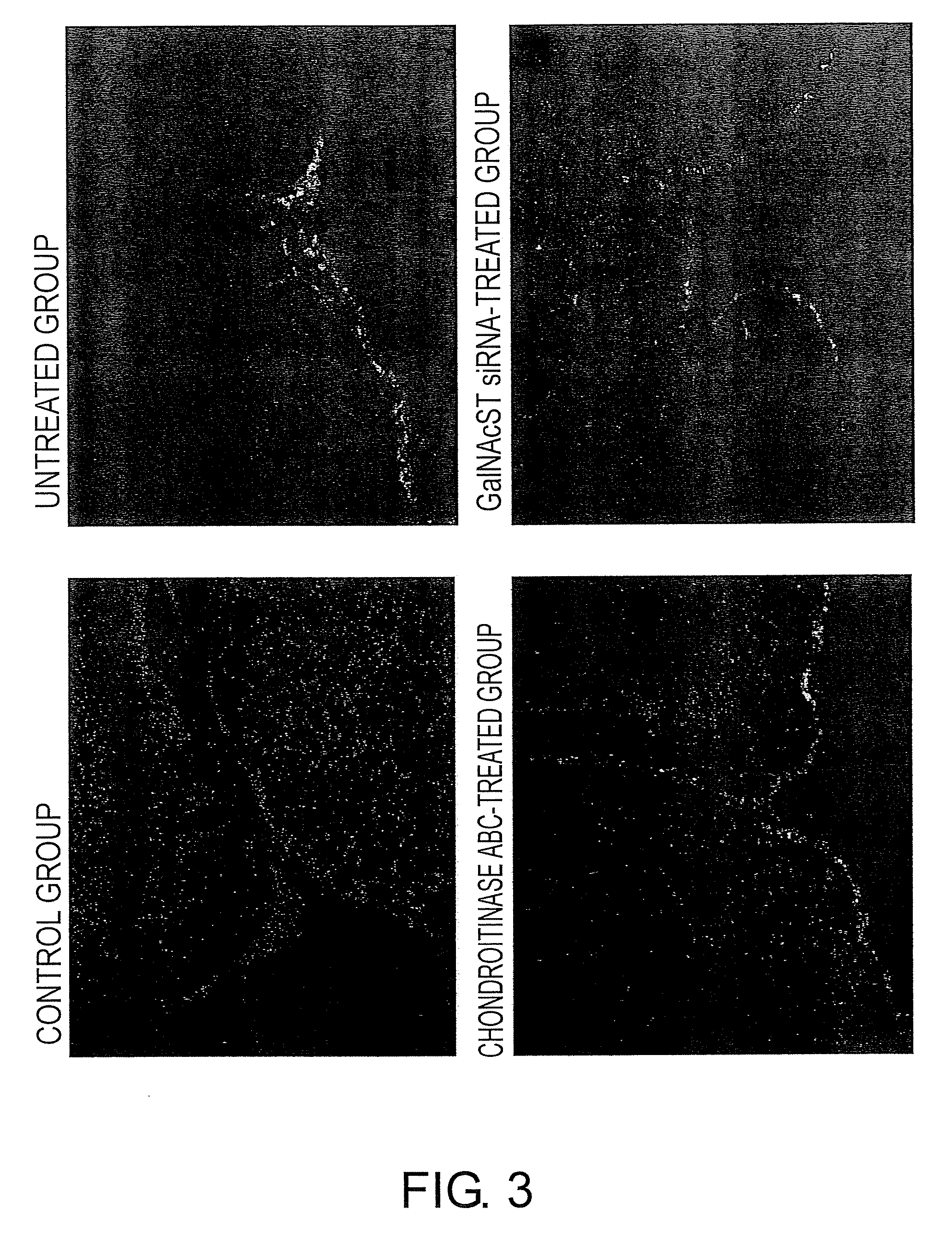Agents for suppressing neural fibrotic degeneration
a neural fibrotic and agent technology, applied in the direction of drugs, peptides/proteins, instruments, etc., can solve the problems of cognitive function restoration, relative increase in acetylcholine level, and no decisive therapeutic method or agent has been established, so as to achieve the effect of suppressing neural fibrotic degeneration and great medical and industrial significan
- Summary
- Abstract
- Description
- Claims
- Application Information
AI Technical Summary
Benefits of technology
Problems solved by technology
Method used
Image
Examples
example 1
Examination of the Expression of the GalNAc4ST-1 and GALNAC4S-6ST Genes After Treatment with GalNAcST (siRNA) or Chondroitinase ABC in MPTP-induced C57BL / 6JcL Parkinson's Disease Model Mice
[0202]In this example, a mouse model for Parkinson's disease was created by selectively degenerating dop amine neurons using 1-methyl-4-phenyl-1,2,3,6 tetrahydropyridine (MPTP)(Amende et al. (2005) Journal of NeuroEngineering and Rehabilitation 2(20), 1-13); a GalNAcST siRNA agent or chondroitinase ABC agent was administered to these mice, and gene expression and tissue appearance after the treatment were examined and compared.
[0203]14-day pregnant C57BL / 6JcL mice (CLEA Japan Inc.) were fed and allowed to deliver. Each of the 8-week-old female C57BL / 6JcL mice (CLEA Japan Inc.) were intraperitoneally administered with 100 μl of 4 U / ml chondroitinase ABC (Sigma Aldrich Japan) or 200 μl of a mixture consisting of 1 μg of GalNAcST siRNA (a mixture of cocktail sequences of GalNAc4ST-1, GalNAc4ST-2, and...
example 2
Comparative Examination of Intracerebral CSPG Deposition-Suppressing Effect of Chondroitinase ABC and GalNAcST siRNA Treatments in the MPTP-Induced C57BL / 6JcL Parkinson's Disease Model Mice
[0210]In this Example, the CSPG deposition-suppressing effect was examined and compared using brain tissue samples from Parkinson's disease model mice. The brain tissues obtained in Example 1 were embedded in the freezing embedding medium OCT compound (Miles Lab.), and placed in liquid nitrogen to prepare frozen blocks. The frozen blocks were sliced into 10-μm sections using a cryostat (Microm). The resulting sections were fixed in acetone (Sigma Aldrich Japan) for ten minutes, and then washed with phosphate buffer. An anti-chondroitin sulfate proteoglycans (CSPG) antibody (clone CS56, mouse monoclonal antibody, 10 μg / ml; Seikagaku) was added as the primary antibody, and the sections were reacted at room temperature for one hour. Then, the secondary antibody reaction was conducted using a Histofin...
example 3
Comparative Examination of the Effect of Chondroitinase ABC and GalNAcST siRNA Treatments in Suppressing Inflammation Associated with Macrophage Infiltration in MPTP-induced C57BL / 6JcL Parkinson's Disease Model Mice
[0211]As shown in Example 2, CSPG deposits are known to absorb chemokines, which are in vivo substances that induce inflammatory cells such as macrophages. Since it was hypothesized that CSPG deposition attracted inflammatory cells and thereby resulted in the induction of brain tissue destruction, the effect of GalNAcST administration and chondroitinase ABC on the intracerebral macrophage accumulation was also compared using the same brain samples as described in Example 2. Sections prepared by the same method as described in Example 2 were fixed with 4% paraformaldehyde (PFA)-phosphate buffer (Nacalai Tesque) for ten minutes, and then washed with deionized water. A rat anti-mouse macrophage antibody (clone F4 / 80, at 1:200 dilution; BMA) was added as the primary antibody,...
PUM
| Property | Measurement | Unit |
|---|---|---|
| Degradation properties | aaaaa | aaaaa |
Abstract
Description
Claims
Application Information
 Login to View More
Login to View More - R&D
- Intellectual Property
- Life Sciences
- Materials
- Tech Scout
- Unparalleled Data Quality
- Higher Quality Content
- 60% Fewer Hallucinations
Browse by: Latest US Patents, China's latest patents, Technical Efficacy Thesaurus, Application Domain, Technology Topic, Popular Technical Reports.
© 2025 PatSnap. All rights reserved.Legal|Privacy policy|Modern Slavery Act Transparency Statement|Sitemap|About US| Contact US: help@patsnap.com



